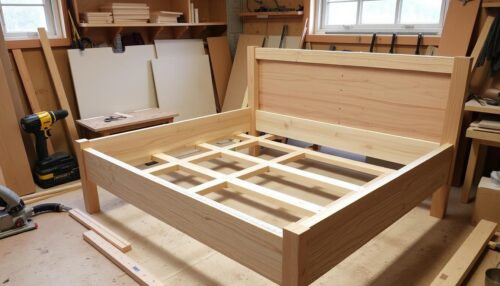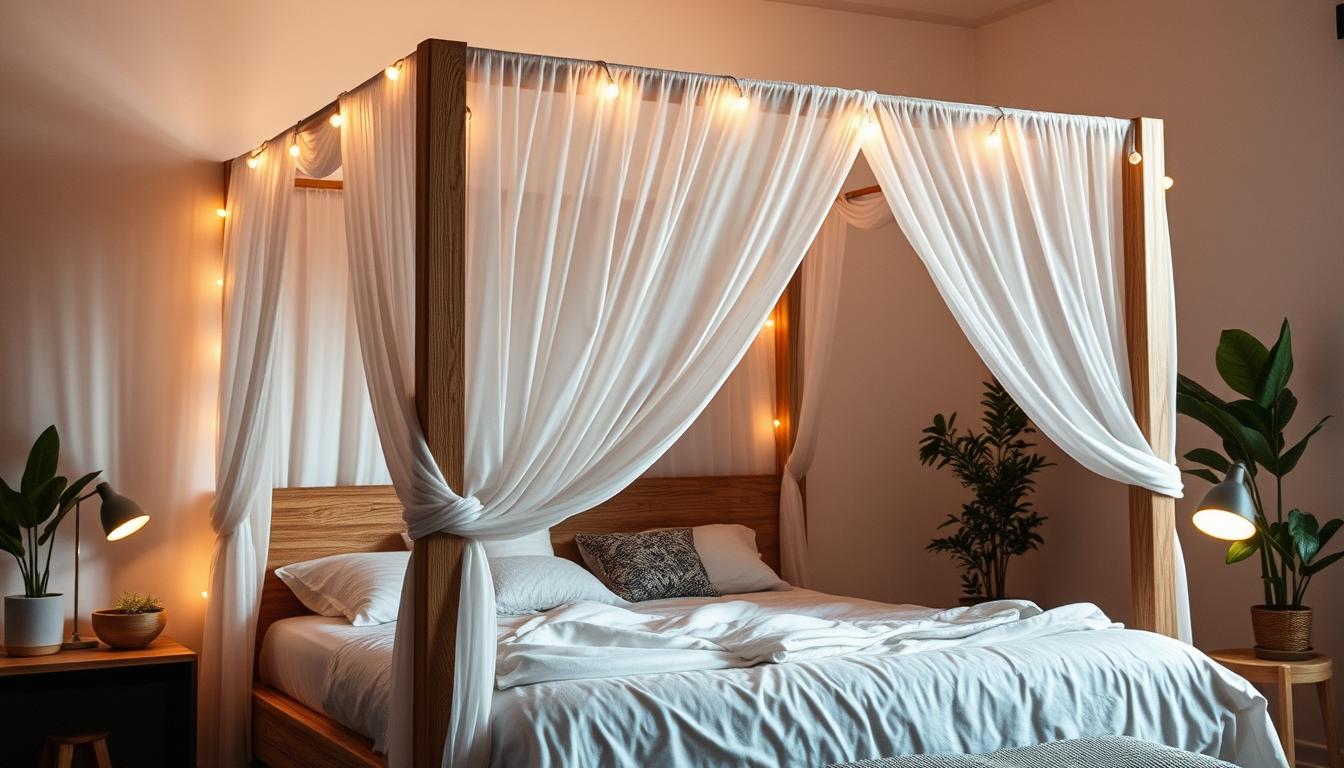Disclosure
This website is a participant in the Amazon Services LLC Associates Program, an affiliate advertising program designed to provide a means for us to earn fees by linking to Amazon.com and affiliated sites.
Imagine turning your bedroom into a cozy, luxurious retreat with a DIY canopy bed frame. It’s perfect for both seasoned DIYers and beginners. Making your own canopy bed is rewarding and lets you customize it.
Canopy beds are back in style, fitting many décor themes. They offer a covered top, making your sleep area cozy and private. With the right materials and creativity, you can add this classic look to your home.
Key Takeaways
- Canopy beds add a timeless touch that can be modernized.
- Making your own canopy bed is a fun, personal project.
- They come in many styles, from simple to fancy.
- Think about your bedroom size, ceiling height, and style when choosing a canopy bed.
- Building a DIY canopy bed is a rewarding, budget-friendly option.
Introduction to DIY Canopy Bed Frames
Canopy beds add elegance and charm to any bedroom. They create a cozy, private space and draw attention to the room. If you want a canopy bed, DIY is a great choice.
Why Choose a Canopy Bed?
Canopy beds are tall, reaching up to 7 feet. They fit well in rooms with high ceilings. Originally, they offered privacy and warmth in shared spaces. Now, they add comfort and intimacy to your bedroom.
Benefits of Going DIY
- Personalization: DIY lets you customize the design and materials to fit your style.
- Cost-savings: Making your own bed saves money, helping you stay within budget.
- Sense of Accomplishment: Creating your own furniture is rewarding and fulfilling.
There are many styles to choose from, like classic four-posters or modern hoop canopies. With the right tools and materials, you can make your bedroom a dreamy oasis that shows off your style.
Materials Needed for Your Project
Making your own canopy bed frame needs the right tools and materials. First, get the basic tools like saws, drills, and measuring tools. The right tools make building easier and more successful.
Essential Tools for Building
- Circular saw or miter saw for cutting wood
- Power drill and drill bits for creating holes and assembling the frame
- Measuring tape, ruler, and level to ensure precise measurements and alignment
- Clamps to hold the wood pieces in place during assembly
- Sandpaper or an orbital sander for a smooth finish
- Wood glue and screws for a sturdy and long-lasting construction
Suggested Wood Types for Frames
For the bed frame construction, use hardwoods for their strength and beauty. Oak, maple, and cherry are good choices. They are strong and look great, fitting well with bedroom makeover ideas.
| Wood Type | Characteristics |
|---|---|
| Oak | Sturdy, with a distinctive grain pattern; a classic choice for canopy beds |
| Maple | Dense and strong, with a smooth, uniform texture; adds a clean, modern look |
| Cherry | Warm, reddish-brown hue; offers a luxurious and sophisticated appearance |
Choose wood that’s strong and sturdy for your canopy bed frame. This ensures it lasts long and can hold the canopy’s weight.
Design Options for Canopy Beds
Choosing the right canopy bed can change your bedroom’s look. You can pick from many styles, from old-fashioned to modern. Knowing the difference between traditional and modern designs helps you choose the best fit for your room.
Traditional vs. Modern Styles
Traditional canopy beds have fancy headboards and posts. They make your room feel like a royal place. Modern canopy beds are simpler, with clean lines. They fit well in many room styles.
How to Choose Your Design
- Think about your bedroom’s size and layout. Canopy beds are big, so make sure your room is big enough.
- Decide what style you like. Do you want a classic four-poster or a modern canopy?
- Look at different headboard designs and four-poster bed plans. Find one that looks good and works well.
- Feel free to mix styles. You can mix old and new to make your bed truly yours.
By thinking about your space, style, and needs, you can find the perfect canopy bed. It will make your bedroom cozy and inviting.
Step-by-Step Guide to Building a Canopy Bed
Ready to make your bedroom cozy with a DIY canopy bed? First, get the right tools and materials. Make sure your workspace is bright and has good air flow. This will help you work comfortably.
Constructing the Frame
Start by making the base of your canopy bed. Measure and cut the 2×4 boards to the right size. Then, put the frame together. Attach the 4×4 posts to the corners for the base of your canopy.
Next, add the support rails between the posts. This makes sure your frame is strong and even.
Adding the Canopy
Now, build the top frame with 2×10 boards. Attach it to the top of the posts. This is where your canopy fabric will go.
Choose your fabric and hang it around the bed. This will make your bed cozy and inviting.
Always think about safety while building. Wear the right protective gear and follow the instructions carefully. This will help you make a strong and beautiful DIY bed woodworking plans and DIY canopy bed frames.
Finishing Touches
As you near the end of your DIY canopy bed frame project, it’s time for the final touches. These steps will make your creation shine. From sanding and painting to picking the perfect fabrics, these steps are key.
Sanding and Painting Your Bed
Before painting or staining, sand the whole frame. This makes the surface smooth for the finish. Start with coarse grit sandpaper and move to finer grit for details.
After sanding, wipe away dust. Then, you’re ready to paint or stain. You can choose classic white or bold colors. Even try metallic accents or a distressed finish for a unique look.
Choosing the Right Fabrics
The fabric for your canopy bed’s draping is important. Choose sheer curtains for a romantic feel or velvet for coziness. Mixing textures and patterns adds interest.
Think about how the fabric fits with your room’s style. A matching color palette and patterns make your room look polished.
Safety Tips for DIY Projects
When you start your DIY canopy bed frame, safety comes first. Making sure your bed frame is strong and stable is key. Here are some tips to help you avoid mistakes:
Ensuring Stability and Strength
Using the right joinery is important for a strong bed frame construction. Try pocket hole joinery, mortise and tenon joints, or lap joints. These help keep the frame steady and prevent it from wobbling.
Always check if the frame is stable. If it’s not, tighten the connections right away.
Avoiding Common Mistakes
One big mistake is not making sure the bed is level. Use a level to check if it’s even. If not, adjust the legs or supports.
Also, make sure the canopy has enough support. Heavy fabric can strain the frame if it’s not reinforced well.
Always put safety first in your DIY projects. By following these tips, you can build a sturdy canopy bed. You’ll be proud and safe using it.

| Safety Considerations | Key Recommendations |
|---|---|
| Stability | Use proper joinery techniques, regularly check for looseness, and tighten connections as needed. |
| Leveling the Frame | Ensure the bed sits evenly on the floor using a level and adjustable legs or supports. |
| Canopy Support | Reinforce the frame to provide adequate support for the weight of the canopy fabric. |
By following these safety tips, you can enjoy your DIY canopy bed frame with confidence.
Customizing Your Canopy Bed
Customizing your canopy bed opens up endless possibilities. You can add unique design elements or practical storage. This makes your canopy bed truly yours.
Ideas for Unique Canopy Designs
Look into bedroom furniture projects and headboard designs for inspiration. Use natural materials like rattan or bamboo for a boho-chic look. Add warm lighting, like LED strips, for a cozy feel.
Incorporating Storage Solutions
Add storage to your canopy bed for more space. Built-in drawers or shelves in the headboard or footboard are great. You can also use under-bed storage, like pull-out drawers, to keep things tidy.
| Canopy Bed Feature | Benefit |
|---|---|
| Woven Materials | Adds a natural, bohemian touch to the bedroom |
| Integrated Lighting | Creates a warm, inviting ambiance within the canopy |
| Built-in Storage | Maximizes space efficiency and keeps the bedroom organized |
By exploring customization options, you can make your canopy bed unique. It will blend style and function, creating your dream sleep space.
Budgeting for Your DIY Canopy Bed
Starting a DIY canopy bed project is exciting and rewarding. But, knowing the costs is key. Each choice, from wood to fabric, affects your budget. By understanding costs and finding ways to save, you can make your dream bed without spending too much.
Estimated Costs Breakdown
The cost of a DIY canopy bed varies. It depends on the materials and features you pick. You might spend $200 to $2,000 or more. The main costs are:
- Wood type: Hardwoods like maple, oak, or cherry cost more than softwoods like pine or cedar.
- Canopy fabric: Fancy fabrics like silk or velvet are pricier than basic cotton or linen.
- Additional features: Fancy carvings, decorative hardware, or custom touches increase the price.
Tips to Save Money
You can make your dream DIY canopy bed without spending a lot. Here are some tips to save:
- Repurpose materials: Use old furniture wood or fabric from unused curtains.
- Shop for sales: Watch for discounts on hardware, lumber, and fabrics to cut costs.
- Do it yourself: Building the frame and installing the canopy yourself saves money.
Comparing DIY to pre-made beds, DIY often saves a lot. With planning and creativity, you can make a beautiful, custom canopy bed. It will fit your budget and enhance your bedroom.
Maintaining Your Canopy Bed
Getting a DIY canopy bed is a big step for your bedroom. It’s important to take care of it to make it last. Regular upkeep keeps your bed looking great and safe for a long time.
Cleaning Tips for Longevity
Keep the bed frame and fabric clean to avoid dirt buildup. Wash the removable canopy fabrics as the label says. This could be in a machine or at a dry cleaner.
Don’t forget to clean the canopy itself. It catches dust and dirt fast.
When to Make Repairs
Check your DIY canopy bed often for damage. Fixing problems quickly is key to keeping it safe and sturdy. Tighten screws, fix broken parts, or replace damaged items to keep your bed in top shape.
With these easy care tips, your DIY canopy bed will stay a stunning part of your DIY bedroom decor and bedroom furniture projects for many years.
Inspiring DIY Canopy Bed Ideas
Make your bedroom more elegant with DIY canopy bed tutorials. You can choose from simple or fancy designs. These projects help you make your bedroom special.
Minimalist Canopy Beds
For a modern look, try a minimalist canopy bed. They have sleek frames and simple fabrics. This creates a calm, airy feel.
These beds fit well with many decor styles. They work in both modern and traditional bedrooms.
Luxury Canopy Inspirations
For a fancy look, check out luxury canopy bed ideas. Think of a wooden frame with fancy carvings and thick, fancy fabrics. This makes your room feel grand and stylish.
Add things like ribbons or artwork to make it even more beautiful. DIY canopy bed tutorials let you make your bedroom unique. You can make it comfy and stylish.

| Canopy Bed Style | Price Range (Queen Size) | Key Features |
|---|---|---|
| Italian Campaign Canopy | $1,698 | Elegant brass hardware, airy linen canopy |
| Chinoiserie Inspired Gold Leaf | $2,997 | Intricate gold leaf detailing, plush velvet canopy |
| Campaign Canopy Bed | $1,199 | Distressed wood frame, canvas canopy with finial options |
| Cairo Canopy Bed | $999 | Sleek metal frame, bell-shaped canopy with finials |
Troubleshooting Common Issues
Building your own DIY canopy bed frame is rewarding. But, you might face some problems. Don’t worry about a wobbly frame or fabric hang-ups. With some troubleshooting and fixes, you can fix these issues and enjoy your new bed.
How to Fix Wobbly Frames
Wobbly frames are a common problem. It can be due to loose joints or not enough bracing. To fix it, start by tightening all screws and bolts. If it’s not fixed, add more support like diagonal braces.
Dealing with Fabric Hang-ups
Fabric hang-ups are another issue. They can happen if the fabric is not tight enough or if the hardware is poor. Make sure to pull the fabric tight and secure it well. Use good curtain rods and rings to avoid sagging.
Fixing problems with your DIY canopy bed quickly is key. It keeps your bed looking good and working well. With a bit of troubleshooting and some easy fixes, your bed will be a beautiful part of your room for many years.
Conclusion and Encouragement
Congratulations on finishing your DIY canopy bed project! You should be very proud of your work. You’ve made a beautiful piece of furniture and learned new skills.
By doing this project, you’ve made your bedroom special. It now shows off your personal style.
Celebrate Your DIY Success
Take time to enjoy what you’ve done. Making a canopy bed from scratch is a big achievement. You’ve shown your creativity and problem-solving skills.
Feel proud of what you’ve made. You’ve built something amazing with your own hands.
Sharing Your Creation with Others
Don’t hide your DIY bed! Show it off to family, friends, and the DIY bedroom decor world. Post pictures on social media or home improvement sites.
Your bed can inspire others to try their own homemade bed frames projects. Your story can help others reach their DIY dreams.

